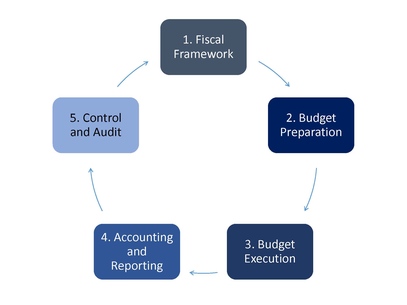Announcement: FAD Workshop on Gender Budgeting at the JVI
October 20, 2017


Figure 1: PFM cycle
Gender Budgeting initiatives on the agenda of many European countries aim to promote gender equality through fiscal policy, or by integrating gender issues into the governments’ Public Financial Management (PFM) system. However, countries are yet to develop a comprehensive Gender Budgeting PFM approach as suggested in recent FAD analytical work. The Joint Vienna Institute (JVI) and the IMF’s Fiscal Affairs Department (FAD) are planning to organize a workshop for countries in Eastern and Southeastern Europe to introduce FAD’s PFM approach to gender budgeting, help foster peer learning, and plant the seeds for a potential possible Community of Practice in the region.
Gender equality is on the government’s policy agenda in many countries from different regions and income groups.[1] While gender equality is an important development goal, studies suggest that raising women’s participation in the economy can also boost GDP growth,[2] support economic diversification, and tackle income inequality.[3]
Although progress in closing gender gaps across the world has been made, there is still a large unfinished agenda. For example, in advanced countries, women’s labor market participation rate is about 17 percentage points lower than men’s. The wage gap between women and men amounts to roughly 14 percent. The share of male managers is almost double that of women, and almost 70 percent of unpaid work is performed by women. And even though there is a growing number of women in parliaments and senior managerial positions in companies, they are still under-represented on average across the world.
A similar picture can be observed in Central, Eastern, and Southeastern Europe (CESEE) countries. On the positive side, the average labor force participation rate for women in the region was 76 percent in 2016, higher than the average rate of 68 percent for the world.[4] Nonetheless, gender gaps in some areas still exist, and countries of the region are considering and implementing gender budgeting initiatives to further promote gender equality.
Gender budgeting may be defined as the fiscal policies and PFM practices that support the promotion of gender equality. The application of gender budgeting requires the development of mechanisms and tools for the analysis and implementation of fiscal policies, on the expenditure and revenue side and budgetary practices, that have a positive impact on gender equality.
A recent FAD paper[5] argues that gender budgeting can be understood as good budgeting with a gender perspective. It is important that this perspective be integrated into the various stages of the budget cycle, and applied to existing PFM procedures (see Figure 1). Good PFM practices on gender budgeting include:
- A legal foundation for gender-responsive budgeting.
- Gender budgeting statements defining strategic goals for improving gender equality, with operational measures and performance indicators to monitor progress.
- Progress reports on the impact of gender-related policies.
- Integration of a gender perspective into spending programs and performance-based budgeting.
- Gender impact assessments that assess the outcome of gender-related policy initiatives.
- Ex post evaluations and audits of the effectiveness of gender-related policies.
Some of the above-mentioned elements of gender budgeting have been introduced in CESEE countries, as the following examples from the region demonstrate:
- Austria is a world leader in gender budgeting, supported by a constitutional mandate for all levels of government, and an approach that fully integrates gender budgeting into the country’s performance budgeting system. Notable features include a gender budget statement; comprehensive reporting on gender-related objectives; gender impact assessments; and integration of a gender perspective into audits.
- In Albania, as in the Austrian model, the government is required by law to identify gender equality objectives in the Medium-Term Budget Program; and there are gender-related criteria for the distribution of the Regional Development Funds.
- Macedonia developed a Strategy on Gender Responsive Budgeting in July 2012, aiming to systematically include the principle of equal opportunities in all budget processes; the collection and analysis of gender-disaggregated data; establishment of an oversight committee; and consultations with civil society.
- Work on gender budgeting in Ukraine is aligned with budgetary and public administration reforms. The initiative aims at increasing economic efficiency and effectiveness in budget allocations by considering the needs of both genders.
To support these important initiatives in the region, FAD and the JVI will bring together countries to: (i) develop a better understanding of gender budgeting practices and their integration with the PFM cycle; (ii) present innovations in gender budgeting and the challenges they face; (iii) initiate a dialogue among the participating countries on the design and implementation of gender budgeting initiatives and practices, with the objective of learning lessons and improving the impact of these initiatives.The workshop will include government representatives from various agencies—including gender policy coordination units, ministries of finance, and specific sectors—as well as regional experts supporting gender budget initiatives, such as UN Women in the region. The JVI will contact the countries of the region and ask for nominations for the workshop, which will be held at the Joint Vienna Institute in Vienna from February 20-22, 2018.
Carolina Renteria, Division Chief, Fiscal Affairs Department, IMF; Asel Isakova, Economist, JVI; and Johann Seiwald, Senior Economist, Fiscal Affairs Department, IMF











